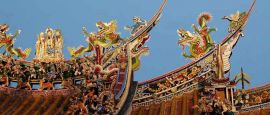Taiwan History, Language and Culture
History of Taiwan
Taiwan's history is shaped by waves of migration, colonisation, and cultural exchange. For thousands of years, the island was home to indigenous Austronesian peoples, whose diverse cultures still survive today in Taiwan's mountains and outer islands. The 17th century saw the arrival of European powers, with the Dutch and Spanish establishing trading posts before being driven out by Chinese Ming loyalist Koxinga, who set up a short-lived kingdom.
Taiwan later became part of the Qing Empire, drawing settlers from China's Fujian and Guangdong provinces. In 1895, following defeat in the First Sino-Japanese War, Taiwan was ceded to Japan, which ruled the island for fifty years. The Japanese period left a lasting legacy—modern infrastructure, a strong education system, and architectural influences still visible in towns and cities today.
After World War II, Taiwan was placed under the control of the Republic of China (ROC). Following the Chinese Civil War, the ROC government, led by Chiang Kai-shek, retreated to Taiwan in 1949 after the Communist Party took control of mainland China. Taiwan then entered a period of authoritarian rule under martial law, which lasted until the late 1980s.
The decades since have seen Taiwan transform into a thriving democracy and one of Asia's most vibrant societies. Its unique political status remains a sensitive issue—it operates as a de facto independent state, with its own government, military, and economy, though it is not universally recognised as a separate nation. Today, Taiwan blends deep historical roots with a strong sense of identity and openness, offering visitors a fascinating window into a place that is proudly itself.
Did you know?
• Taiwan uses two official calendars – the Gregorian and the Minguo, which began in 1911 with the founding of the Republic of China.
• Taiwan's National Palace Museum holds one of the largest collections of Chinese imperial artefacts in the world; many of which were evacuated from Beijing's Forbidden City during the Chinese Civil War.
• Taiwan is home to the world's highest building made from bamboo-inspired architecture—Taipei 101, designed to withstand typhoons and earthquakes, draws on both cutting-edge engineering and traditional symbolism.
Language in Taiwan
The official language of Taiwan is Mandarin Chinese (also known as Guoyu), and it's used in government, education, and media. However, many Taiwanese also speak Taiwanese Hokkien (commonly referred to as "Taiwanese"), especially in the south and among older generations.
While English is taught in schools and many younger people have a basic grasp, it's not widely spoken outside of major cities or tourist areas. That said, signs in English are common on public transport and at most tourist attractions, and locals are generally helpful—gestures, translation apps, and a friendly attitude go a long way.




 You know where
You know where